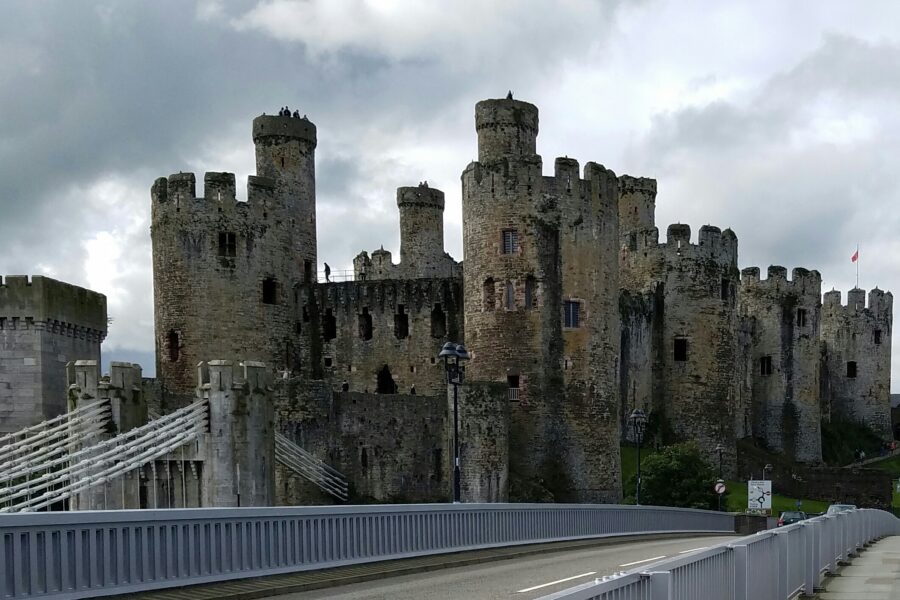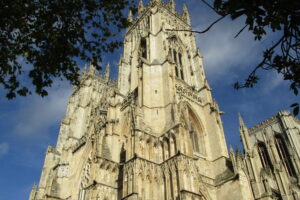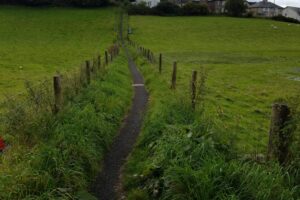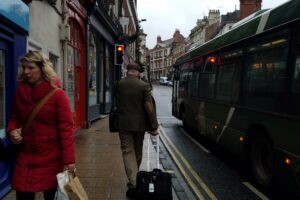

Michael opts to wait downstairs while I run upstairs to gather my things for the day. Walking out the door of the inn, I am told to hurry, the bus is about to leave. I wasn’t aware a bus was going to be a part of this Sunday picture, but I’m flexible. We are the only travelers aboard as it heads for parts unknown; zooming through the city gates across the River Conwy, ending up in the most elegant Victorian seaside resort town I have ever seen—Llandudno. Who knew? I sure didn’t. It is so perfect it almost looks like a movie set.
Llandudno

The gracefulness of Llandudno exists for a reason. No businesses, other than hotels are allowed on the promenade, and the hotel owners must choose from a color palette of understated pastels to paint their building facades. The result is stunning opulence. On the other end of the spectrum, on the very end of the promenade, is the ridiculously gaudy entertainment pier, where the word understatement is not in anyone’s vocabulary.


Wandering among the English tourists of this resort town, Michael keeps eyeing a steep pile of rock that backs up to the large pier, where many two-legged creatures work their way to the top. I try hard to divert his attention to other attractions.

Conwy Castle
Back in Conwy we purchase tickets to explore the castle ruins. Michael and I are both distracted by their gift shop. Souvenirs never looked so good, so tasteful. I keep eyeing a beautiful tapestry box for a £100, but I can’t figure out how to get it home without tossing out some of my clothes.
The castle walls before us—looking like they burst from the earth rather than being built upon it—I am suddenly more interested in the man that caused the edifice to be here than I am in the castle itself. If it hadn’t been for Edward I the castle wouldn’t be here, and probably, neither would we—it was the castle that lured me to Conwy.



Googling like mad, I have obtained bits and bobs (I may as well use English expressions while I’m here—plus I like them!) about King Edward I from various sources. Possessing a fierce temper, he was the son of a weakling father and in turn the father of a weakling son. He was also touted as one of the most formidable and effective of all English kings. Known as Longshanks because of his 6’2” height, Edward I was also called Hammer of the Scots and Conqueror of Wales.
From afar we always see a myriad of individuals standing high on the turrets; they are still there this early afternoon. These turrets are Michael’s ultimate goal—they are my last. It’s not that I am afraid of heights—I just don’t love them. He coaxes me higher than I really want to go, and while he climbs higher still, I explore the ruins around me, eventually finding a stone in a corner of the ramparts where I take up residence and read about the Druids and wonder even more about Edward I.

A Very Light Lunch at the Pub
After Michael’s climb, and before we tackle the town walls, he asks if I’d like a gin and tonic. Following him into the Erskine Arms, we find a small table with comfortable seating in a tiny room. I have wine while he has a local gin. I decide we need a snack to offset the alcohol so I walk to the bar, look at the menu and settle for goujons. Our fish sticks are four slender strips of crispy fried plaice, served with a caper-heavy tartar sauce.

Conwy Town Walls
We attack the town walls. Thinking that it will be a flat leisurely stroll once we climb the steps, I am quickly defeated. I arrive breathless—along with everyone else—at the southeast corner of the wall.

Conwy is tiny and very walkable, although in many instances not car friendly. Certainly not coach friendly. We stand with a large group of English tourists, looking at the street below, watching as a large bus tries to scrape its way through the arched tunnel in the city walls. I overhear derogatory remarks about woman drivers. We walk on amid a myriad of chimney stacks which look like other-worldly creatures straight from Star Wars.

We were never sure if the bus would make it through. The driver crept inch by painful inch.

The benches we see below our high-walled perch lure us to the beach. Back at sea level, we sit and watch indulgent parents play with their very independent toddler children. Heading back to the hotel, we nap before our evening meal at the hotel’s restaurant. Reservations made after breakfast, the earliest one available was 8:30 p.m.

A Sunday Roast In Wales
I am more than impressed by our starter courses and Oltre Passo Primitivo Salento red wine from Puglia. The description of the wine is enough to cause us to order it. The menu claims Flavours of dried prune, date and plump cherry, with swathes of sweet spice. A mouth coating, chocolatey red wine. Michael’s goat cheese and honey mousse with roasted hazelnuts, apple puree, and marinated beetroot is decadently delicious. My chicken and mushroom arancini served with a tomato and coriander coulis with Parmesan crisps is lighter than expected and equally delicious. We both order a Sunday roast for our entrée—Michael’s with an assortment of meats, mine is strictly lamb; it is pure homespun Sunday dinner at home.



We should sleep well tonight.
A Note about Edward I—
Edward I married when he was fourteen and his bride, Eleanor of Castile, was only thirteen. Together they had sixteen children; I’m glad I wasn’t Eleanor. Edward became king in 1272 at the age of thirty-three, invading Wales four years later. History is convoluted and complicated, so bottom lining it—after defeating the Welsh—Edward set about building and rebuilding a multitude of castles. They were constructed as symbols of subjugation around the throat of native Welsh independence. His fearsome iron ring of colossal fortresses represents Europe’s most ambitious and concentrated medieval building project, designed to prevent the recurrence of two massively expensive military campaigns.
What I find really interesting is that Edward experienced difficulty in paying for his building program. Although the total monetary cost is not known, over a twelve year period he spent £60,000 (about £33 million in today’s terms), more than 10 times his annual income, on building castles and walled towns at Conwy, Caernarfon, Beaumaris and the refurbishment of Llywelyn’s castle at Criccieth. And there were so many more!









Leave a Reply
Your email is safe with us.